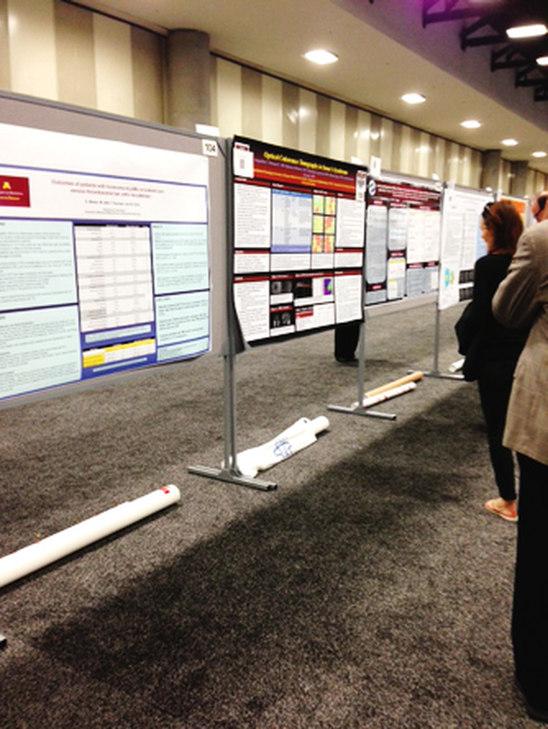Movement disorders, aging, Alzheimer’s disease, behavioural science, and, importantly, basic research and therapeutic advancements in multiple sclerosis (MS) were among the topics that were discussed during the meeting. Information was presented via poster presentations, in which researchers display their data visually on a poster, often standing by to answer questions from visitors, or in scientific sessions, where presentations are grouped together by subject. Of notable interest were the sessions on MS clinical trials, the reported outcomes of which are described in more detail below.
Determining therapeutic advantage of using two MS drugs vs. one
Dr. Fred Lublin from Mount Sinai Hospital in New York and Dr. Jerry Wolinsky from University of Texas Health Science Center presented progress on the CombiRx phase III trial extension. The original clinical trial, which began in 2005 with an enrollment of 1,018 patients, was designed to evaluate the potential clinical benefit of combination therapy with interferon beta-1a (Avonex®, Biogen) and glatiramer acetate (Copaxone®, Teva Pharmaceutical) versus administration of either drug alone. Results from the extension, a long-term follow up, reveal that combination therapy was not superior to either drug alone in terms of reducing relapses.
Proportions of patients relapsing during the 3-year study were as follows:
- Combination: 23.1%
- Glatiramer acetate alone: 20.5%
- Interferon alone: 26.0%
Combination therapy also provided less benefit than individual drugs for other factors such as disability progression and length of time to first relapse. However, MRI results presented by Dr. Wolinsky showed that patients who received combination therapy had fewer lesions as seen on MRI scans than patients who were treated with either agent alone.
This research provides important insight into the cost-benefit analysis of treatment with combined medications. Dr. Lublin noted that more research in this area, as well as more accurate measures of disability in MS clinical trials generally is being actively pursued.
Switching from injectable therapy to oral therapy
A
research team from France initiated an observational study to
evaluate the safety and efficacy (meaning the ability to produce
a beneficial effect) of switching from natalizumab (Tysabri®,
Biogen) to fingolimod (Gilenya®, Novartis Pharmaceuticals) -
first oral therapy approved for use in Canada to treat relapsing-remitting MS. The goal
of this work is to reduce risk of progressive multifocal
leukoencephalopathy (PML), a serious brain infection associated
with use of natalizumab. Results presented by Dr. Mikael Cohen
showed that risk of relapse when switching treatments was 50%.
During “washout” (the period in which patients received no
treatment) disability also increased significantly. Additionally,
a third of the patients who switched to fingolimod treatment
experienced at least one relapse. From this data, researchers
conclude that switching from natalizumab to fingolimod is a not
considered safe enough to serve as a routine treatment option for
patients with MS.
Positive results in trial of a new therapy that modulates immune system activity
Dr. Aaron Miller from Mount Sinai Hospital presented results from a clinical trial assessing the safety and efficacy of teriflunomide (Aubagio®, Genzyme), a once-daily oral therapy that has recently been approved in the US for treatment of relapsing-remitting MS. Data from phase III of the TOWER study, which included 1200 patients treated over 48 weeks, revealed a 36.3% reduction in yearly relapses and 31.5% reduction in disability progression. Dr. Miller concluded that teriflunomide at both 7mg and 14mg doses showed significant therapeutic benefits with few adverse effects.
How long will good effects of Tecfidera™ last?
Dr. Bob Fox from Cleveland Clinic reported on his team’s work observing the longevity of the beneficial response of the recently approved oral drug, dimethyl fumarate (Tecfidera™, Biogen). Results of the phase III evaluation revealed that dimethyl fumarate at doses of 240 mg twice or three times daily lead to a significant reduction in relapses when compared to placebo (treatment with a dummy pill). This effect was observed up to 61 weeks. Further, MRI results demonstrated a significant decrease in brain lesions after 24 weeks. All outcomes described were observed up to 3 years post-treatment.
Extension studies
Results from additional extension studies were presented. The objective of an extension study is to evaluate the long-term effects of a therapy. Information from these studies will aid clinicians and people living with MS make informed decisions when selecting a therapy regimen, and provide a clear understanding of whether the therapeutic benefit and safety of a drug can be sustained beyond its immediate effects.
Long-term results for phase II trial for new MS therapy daclizumab HYP
- Dr. Gavin Giovanni and colleagues in Europe reported on their phase II trial safety and efficacy extension study of daclizumab high-yield process (DAC HYP, Biogen Idec and Abbott Biotherapeutics)
- DAC HYP a liquid preparation of the antibody daclizumab, and has been previously shown to have clinical benefits in patients with relapsing-remitting MS
- Results of the extension study showed that monthly DAC HYP injections continued to reduce relapses, MRI disease activity, and disease progression after 1 year
- There was one reported death due to autoimmune reactions in the liver
- Overall, the safety profile of the drug remained consistent with what was seen in the original trial
- The study is expected to be completed in September 2015
Early vs. delayed treatment of oral laquinimod
- Dr. Giancarlo Comi from Italy presented progress on the ALLEGRO phase III extension study, which compared results from early versus delayed treatment with oral laquinimod (Teva Pharmaceuticals)
- The risk of developing disability was lower for those who started on active therapy in the original trial compared to those who started on placebo and then switched to active therapy during the extension phase
- Teva Pharmaceuticals announced the launch of an additional phase III study, CONCERTO, which aims to determine the effects of different doses of laquinimod
Three year follow-up results for B-cell therapy
- Earlier results from a phase II clinical trial with ocrelizumab (Hoffmann-La Roche Ltd.), a therapy targeting B-cells, showed significant reductions in MRI lesions and frequency of relapses experienced each year compared with a mock drug
- At the 3-year milepost, data presented by Dr. Stephen Hauser showed sustained suppression of disease activity in individuals who continued treatment, with no new serious adverse events identified
- Ocrelizumab is in further testing for relapsing-remitting and for progressive MS, the stage when relapses taper off but functional losses tend to continue.
Alemtuzumab demonstrates consistent safety and efficacy after three years
- Data from a 3-year follow-up study following the CARE-MS and CARE-MS II clinical trials with alemtuzumab (Genzyme and Bayer Healthcare Pharmaceuticals) were presented by Dr. Edward Fox from Central Texas Neurology Consultants
- Alemtuzumab is an antibody which targets and depletes lymphocytes, the white blood cells which are thought to attack myelin in MS
- Efficacy studies revealed very little new MRI or clinical disease activity as well as no new safety concerns
New form of interferon therapy shows positive effects with fewer doses
- Peginterferon beta-1a, which is a modified version of the commonly used drug interferon beta-1a, was tested in a group of 1512 patients
- This version can last longer in the body, which means a less frequent dosing schedule
- Safety and efficacy results of the ADVANCE study showed that under the skin injections every 2 or 4 weeks led to a reduction in annual relapse rate, disability progression and lesion activity on MRI
- Further studies will provide more information on the potential benefits of this more convenient alternative to conventional interferon therapy
New insights on progressive MS
Progressive MS, which has not seen the same rapid advancement in treatment options as relapsing-remitting MS, is gaining increasing attention amongst researchers and neurologists. Breakthrough imaging techniques presented at this meeting demonstrated the ability to more accurately visualize gray matter damage in the brain, a hallmark of progressive MS. Much research has also focused on determining if current therapies can slow down the rate of brain shrinkage.
Current drug may be capable of treating progressive MS
Interesting data was presented from a study showing reductions in the rate of brain volume loss by about one-third of patients on Gilenya® compared to those taking interferon beta-1a or placebo. A larger trial with Gilenya® is now being conducted with more than 1000 participants who have primary-progressive MS to determine the full impact of this drug on disease progression.
Promising new therapy on the horizon
Results
from a pilot study with amiloride were presented at the meeting
session on novel treatments. This oral blood pressure medicine
was tested in a group of 14 people with primary progressive MS
because it had been shown previously to have nerve-protecting
properties. Dr. Tarunya Arun of Oxford University reported that
after 3 years, treatment with amiloride resulted in a reduction
of brain shrinkage associated with progressive disease, compared
to what was experienced before treatment. This study marks an
important milestone in MS research as it replicates in humans
what was seen in earlier studies with animals. This is an example
of translating basic science into therapeutic potential.
Highlights in basic research
Alongside sessions on MS therapies were those which highlighted progress in basic research and new insights about the relationships between MS and quality of life, socioeconomic factors, cognition and lifestyle changes. They included:
Biomarkers—the search continues
- Drs. Francisco Quintana, Howard Weiner and their team at Harvard’s Brigham and Women’s Hospital conducted a study that analyzed serum samples from people with MS who were taking glatiramer acetate, a common drug for MS
- Results showed that a repertoire of antibodies, or proteins produced by the body's immune system when it detects foreign substances, were associated with clinical responses to treatment with glatiramer acetate (Copaxone®, Teva pharmaceuticals)
- Further research in this area can lead to development of screening tools which might predict early on how an individual will react to treatment with glatiramer acetate.
Gene expression patterns point to different stages of MS
- An interesting study described by Dr. John Tossberg from Nashville looked at gene expression patterns as biomarkers that can indicate different stages of MS
- Research from his team reveals a marked increase in the gene which encodes the cytokine Il-33 in patients with clinically isolated syndrome (CIS), or the first onset of demyelination, versus healthy controls
- Cytokines are unique molecules which guide immune cells throughout the body
- Patients who transitioned from CIS to MS also showed a dramatic increase in Il-33 compared to healthy controls as well as to patients who were further along in the course of MS
- This study suggests the valuable potential of Il-33 measurements as an indicator of progression from CIS to MS
Better identification of progressive vs relapsing-remitting MS
- A research team from Boston presented results which establish microRNAs as potential biomarkers that can help differentiate between relapsing-remitting MS and different phases of progressive MS
- MicroRNAs are segments of DNA that are involved in gene expression. They can be collected easily from the blood for testing
- Results of this study suggest a possible use of these molecules in staging MS disease, which in turn would aid clinicians in determining appropriate treatments based on type of MS and disease severity as well as enable earlier treatment to prevent development of the progressive phase of MS
Vitamin D—the controversy continues
In a pilot study assessing the effects of vitamin D in MS, preliminary data showed no significant changes in levels of cytokines (chemicals which guide activity of immune cells) provoked by vitamin D, but researchers noted a decrease in CD161 expression in the high vitamin D dose group vs low dose group. Cd161 is molecule found on the surface of Th17 lymphocytes, which are immune cells that have been previously demonstrated to drive autoimmunity. Future studies are required to determine the safety, immunological response, and ultimately the clinical efficacy of vitamin D supplementation as treatment for MS.
Dr. George Ebers, a former practicing neurologist and professor in London, Ontario and now a professor at Oxford University in the UK, presented recent findings on the interaction between genetics, environment, and levels of vitamin D and the risk of developing MS. He noted that in Europe MS incidence increases with distance from the equator which is believed to be a result of decreased vitamin D due to less exposure to sunlight.
The debate on vitamin D
Dr. Ebers participated in a debate on whether there is enough available evidence on vitamin D to warrant its use for prevention of MS. Dr. Ebers, who supports vitamin D supplementation at a daily dose of 4,000 IU, argued that repeated studies have demonstrated the safety of Vitamin D in daily doses as high as 120,000 IU. He also reported on a study in Norway in which individuals who suffered from rickets, a disease caused by vitamin D deficiency, were also diagnosed with MS. The Norway study adds to a growing body of evidence demonstrating a potential link between vitamin D and MS.
Conversely, Dr. Alberto Ascherio from Boston, MA, suggested that vitamin D supplementation should be withheld until long-term safety studies are conducted. He argued that the biological nature of vitamin D makes it unpredictable, and that there have been examples of vitamin supplementation therapies that have had adverse effects (i.e. Vitamin A).
Lifestyle and Environment
Exercise may benefit the brain
A small study led by Drs. Victoria Leavitt and John DeLuca from the Kessler Foundation in New Jersey tested whether aerobic exercise impacts the brain. Using MRI scans and memory tests, they discovered that 30 minutes of aerobic exercises for 30 minutes, 3 times a week over 3 months improved memory and increased the volume of the hippocampus, a part of the brain involved with memory and other functions. These results are preliminary and thus require additional follow-up.
Pregnancy and MS
Barbara
Teter and colleagues presented on the long term effects of
pregnancy on MS disease progression. Previous evidence has
illustrated that pregnancy in MS is associated with a decrease in
number of relapses, followed by a rebound in the first month
after birth. Researchers analyzed data from 1195 pregnant and 328
non-pregnant women with MS. Results revealed that women who have
gone through pregnancy take a longer time to reach EDSS 6 (high
disability), compared to women who were never pregnant,
suggesting a long term pregnancy benefit in MS. Further studies
are necessary to affirm this effect and whether it will influence
a woman’s decision to bear children if she has MS.
Update on CCSVI
Prevalence of CCSVI in MS
Dr. Robert Fox and colleagues at Cleveland Clinic and Case Western Reserve reported preliminary results from one of the seven CCSVI studies co-funded by the MS Society of Canada and National MS Society. The study involved 61 people with different types of MS and 20 people without MS. They used ultrasound techniques that included technicians trained in CCSVI assessment that remained unaware of the participants’ disease status. Results of the study showed no significant difference between the non-MS and MS groups.
CCSVI treatment in MS
First results from a controlled trial with a form of endovascular treatment were presented by Drs. Robert Zivadinov, Adnan Siddiqui and the team from State University of New York at Buffalo. In this blinded study, 9 people had angioplasty and 10 had a sham treatment. At six months, research reported no adverse effects from treatment, but also found that it failed to provide sustained improvement in venous outflow. They also found that those whose veins increased in outflow tended to have increased MS disease activity seen on MRI.
Conclusion
This summary is a snapshot of the progress in MS research that was highlighted at the 65 th AAN Annual Meeting. As the only national voluntary organization in Canada dedicated to overcoming MS, the MS Society aims to keep members, staff and other external stakeholders up to date on breakthrough MS research that is on the horizon.
As previously noted, much research is undertaken to affirm safety and efficacy of available and emerging therapies in MS. It is clear that more treatment options are available now than ever before, and insights on the basic nature of the disease continue to build. Much of the work described above has been done in collaboration with some of Canada’s brightest scientists and clinicians. We look forward to hearing more on these and other studies that will continue to advance knowledge and treatment in MS.
Copaxone is a registered trademark of Teva Pharmaceutical Industries
Gilenya is a registered trademark of Novartis
Tecfidera is a trademark of Biogen Idec
Tysabri is a registered trademark of Biogen Idec and Elan Pharmaceuticals
Aubagio is a registered trademark of Genzyme




